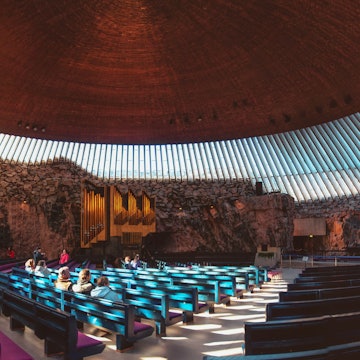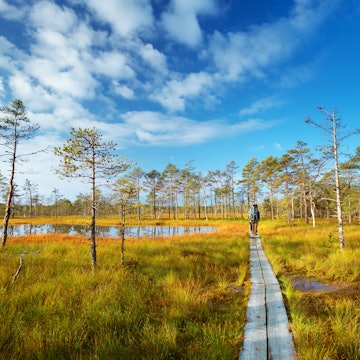

Beautiful view over Old Riga. Leonardo Patrizi / Getty Images
If you don’t already have a connection to Latvia, chances are it may not have crossed your mind as a potential destination for your next trip.
But this Baltic nation has more than a few surprises hidden amidst its lush pine forests and architecturally rich cities and towns. Here are ten reasons to add Latvia to your travel wish list.
Old Rīga
It’s lost its walls and it isn’t as cutesy as others across Europe, but the old town in Latvia's capital, Rīga, still has an impressive array of historic buildings, oversized churches and cobbled lanes. Best of all are the many sunny squares filled with beer gardens and street cafes, which in summer thrum with the cosmopolitan clatter of locals and tourists. In winter Old Rīga does its best impression of a scene from a Christmas card – which is fitting for the place where the very first Christmas tree was erected.
Art nouveau architecture
For fans of this theatrical style of architecture and design, there’s simply no better destination than Rīga. The city’s architects got completely carried away with this trend when it swept Europe around the beginning of the 20th century and, despite the wartime devastation, over 750 art nouveau buildings remain. Gaze up as you wander the streets and you’ll see a great many facades decorated with the swirling nature motives, bare-breasted goddesses and mythological beasts typical of the style. If you want to delve deeper, visit the period apartment which serves as the Rīga Art Nouveau Museum. For art nouveau furniture and fabrics, head to the Museum of Decorative Arts & Design.

Beautiful beaches
First-timers to the Baltic are often surprised by just how beautiful the beaches are. Granted, it doesn’t quite have the climate to match, but in the height of summer, the endless golden sands are a great place to let the kids loose with a bucket and spade. Jūrmala, only 20km from the capital, is Latvia’s swankiest beach town, filled with grand wooden holiday houses and large spa hotels. For a more relaxed vibe, try Ventspils in the northeast.
Soviet reminders
If you’re fascinated by the good, the bad and the ugly of the USSR, they can all be found in this former Soviet republic – although the scales are tipped strongly towards the latter two. ‘The good’ is represented by love-them-or-hate-them buildings such as Rīga’s overblown Academy of Science skyscraper (nicknamed Stalin’s wedding cake) and the boxy modernist building housing the Museum of the Occupation of Latvia. Inside, the museum succinctly summarises ‘the bad’ side of Soviet life such as deportations, gulags and purges. As for ‘the ugly’ – you don’t have to wander too far from the well-scrubbed touristy areas to find plenty of the grey, utilitarian buildings that epitomise the words ‘former Soviet’.

Rundāle Palace
If drab buildings were a hallmark of communism, surely excessive ostentation was the equivalent for the Russian Empire. The remarkable Rundāle Palace, built for the Duke of Courland in the 18th century, is the grandest of its kind in the Baltics, with formal gardens modelled on those at Versailles and 138 rooms within its baroque shell. Inside, the state rooms are slathered with frescoes, moulded plasterwork and gilt trim.

Ancient castles
When German warrior monks pushed into the Baltics in the early 13th century, introducing the locals to the joys of Christianity with the pointy end of their swords, they couldn’t be certain of a warm welcome. Sturdy fortifications were a necessary precaution and castles sprang up throughout the land, many of which are still standing today. Visitors to Cēsis Castle are issued with a candle-powered lantern to explore the darker recesses of its ruined walls. The boxy Livonian Order Castle in Ventspils, by contrast, has been restored and converted into an excellent interactive museum.
Fairytale forests
If you want to get close to the Latvian heart, take a walk through the woods. Forests cover around 45 percent of the country and shelter a diverse range of critters, including a significant population of lynx, beavers and birds of prey. The best places to wander tree-dappled trails are in Ķemeri National Park, a large expanse of forest and bog near Jūrmala, and Gauja National Park, northeast of Rīga. From Sigulda, gateway to Gauja, leafy paths lead between the ruins of three castles and along the Gauja River.

Picturesque towns
Rīga does tend to steal much of the limelight, but more intrepid travellers should consider seeking out some of Latvia’s sleepier centres. Our favourites include pretty little Cēsis, hidden in the forested confines of Gauja National Park, and centred on a large church, ruined castle and ornamental lake. Much further west, Kuldīga boasts Europe’s widest waterfall (249m) – but at a height of only two metres, it’s more scenic than it is dramatic. The best views are from Kuldīga’s old castle grounds, which have been transformed into a leafy park and sculpture garden.

Daugavpils Mark Rothko Art Centre
You might know him as one of America’s most celebrated artists and one of the world’s leading exponents of abstract expressionism, but Mark Rothko (1903-1970) was actually born in Daugavpils in Latvia’s southeast. In 2013 his home town recognised its most famous son with the opening of the Mark Rothko Art Centre (rothkocenter.com). Dedicated to art, culture and education, the centre is located in the arsenal building of a historic Russian-built fortress. The Rothko family stumped up some original works which hang alongside an ever-expanding collection of contemporary Latvian art.
Kooky experiences
From spy games in old Soviet coastal forts to horror scenes acted out in darkened basements, Latvia has a particularly pant-wetting range of experience-based attractions on offer. If you’re a glutton for Soviet-style punishment, report to Liepāja’s creepy old military gaol, Karosta Prison, for a few hours of abuse by costumed KGB operatives. For a more intense experience, you can even stay the night in a cell and get acquainted with the authentically awful toilet facilities.















